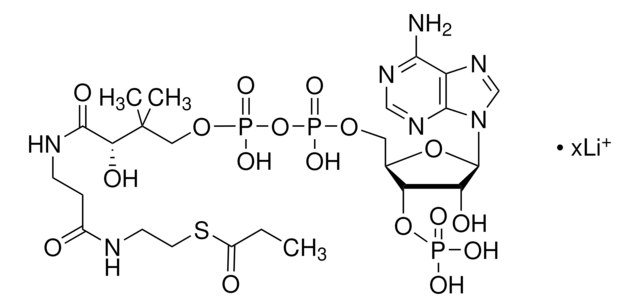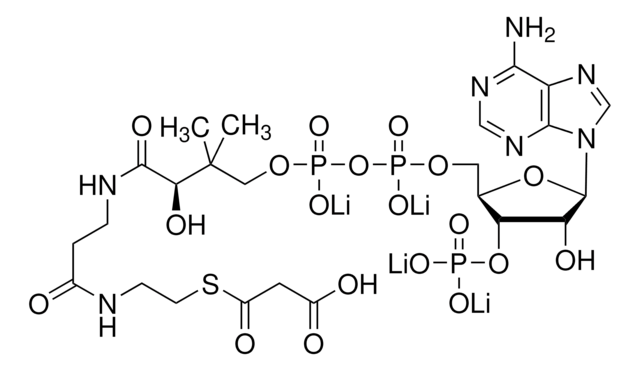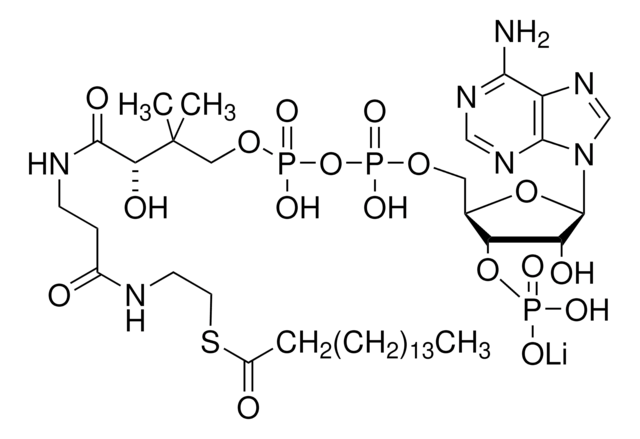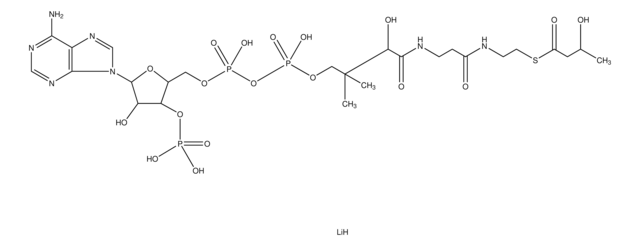S1129
Succinyl-Coenzym A Natriumsalz
≥85%
Synonym(e):
Succinyl CoA sodium salt
About This Item
Empfohlene Produkte
Qualitätsniveau
Assay
≥85%
Form
powder
Löslichkeit
water: 50 mg/mL, clear, colorless
Lagertemp.
−20°C
SMILES String
[Na+].[Na+].CC(C)(COP(O)(=O)OP(O)(=O)OC[C@H]1O[C@H]([C@H](O)[C@@H]1OP(O)([O-])=O)n2cnc3c(N)ncnc23)C(O)C(=O)NCCC(=O)NCCSC(=O)CCC([O-])=O
InChI
1S/C25H40N7O19P3S/c1-25(2,20(38)23(39)28-6-5-14(33)27-7-8-55-16(36)4-3-15(34)35)10-48-54(45,46)51-53(43,44)47-9-13-19(50-52(40,41)42)18(37)24(49-13)32-12-31-17-21(26)29-11-30-22(17)32/h11-13,18-20,24,37-38H,3-10H2,1-2H3,(H,27,33)(H,28,39)(H,34,35)(H,43,44)(H,45,46)(H2,26,29,30)(H2,40,41,42)/p-2/t13-,18-,19-,20?,24-/m1/s1
InChIKey
VNOYUJKHFWYWIR-FZEDXVDRSA-L
Anwendung
- die nicht-enzymatische In-vitro-Succinylierung von Lysin
- als Substrat für die Adipinsäure-Biosynthese in rekombinanten E. coli
- bei der Isocitradehydrogenase(ICDH)-Behandlung zur Succinylierung von Proteinen
- als Substrat zur Untersuchung der Spezifität und Kinetik von Enzymen wie Acetat:Succinat-CoA-Transferase und 5-Aminolevulinat-Synthase (ALA-Synthase)
Biochem./physiol. Wirkung
Signalwort
Warning
H-Sätze
Gefahreneinstufungen
Eye Irrit. 2 - Skin Irrit. 2 - STOT SE 3
Zielorgane
Respiratory system
Lagerklassenschlüssel
11 - Combustible Solids
WGK
WGK 3
Flammpunkt (°F)
Not applicable
Flammpunkt (°C)
Not applicable
Persönliche Schutzausrüstung
dust mask type N95 (US), Eyeshields, Gloves
Analysenzertifikate (COA)
Suchen Sie nach Analysenzertifikate (COA), indem Sie die Lot-/Chargennummer des Produkts eingeben. Lot- und Chargennummern sind auf dem Produktetikett hinter den Wörtern ‘Lot’ oder ‘Batch’ (Lot oder Charge) zu finden.
Besitzen Sie dieses Produkt bereits?
In der Dokumentenbibliothek finden Sie die Dokumentation zu den Produkten, die Sie kürzlich erworben haben.
Kunden haben sich ebenfalls angesehen
Artikel
Get to know the Tricarboxylic acid (TCA) cycle to better inform your research in biochemistry, metabolomics, or related fields concerned with this metabolic pathway and its enzymes, by-products, or intermediates.
Unser Team von Wissenschaftlern verfügt über Erfahrung in allen Forschungsbereichen einschließlich Life Science, Materialwissenschaften, chemischer Synthese, Chromatographie, Analytik und vielen mehr..
Setzen Sie sich mit dem technischen Dienst in Verbindung.















